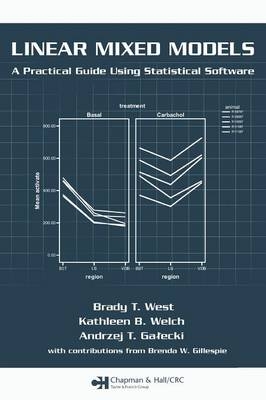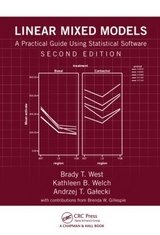
Linear Mixed Models
Chapman & Hall/CRC (Verlag)
978-1-58488-480-4 (ISBN)
- Titel erscheint in neuer Auflage
- Artikel merken
Simplifying the often confusing array of software programs for fitting linear mixed models (LMMs), Linear Mixed Models: A Practical Guide Using Statistical Software provides a basic introduction to primary concepts, notation, software implementation, model interpretation, and visualization of clustered and longitudinal data. This easy-to-navigate reference details the use of procedures for fitting LMMs in five popular statistical software packages: SAS, SPSS, Stata, R/S-plus, and HLM. The authors introduce basic theoretical concepts, present a heuristic approach to fitting LMMs based on both general and hierarchical model specifications, develop the model-building process step-by-step, and demonstrate the estimation, testing, and interpretation of fixed-effect parameters and covariance parameters associated with random effects. These concepts are illustrated through examples using real-world data sets that enable comparisons of model fitting options and results across the software procedures. The book also gives an overview of important options and features available in each procedure.
Making popular software procedures for fitting LMMs easy-to-use, this valuable resource shows how to perform LMM analyses and provides a clear explanation of mixed modeling techniques and theories.
PREFACE
INTRODUCTION
What Are Linear Mixed Models (LMMs)?
A Brief History of Linear Mixed Models
LINEAR MIXED MODELS: AN OVERVIEW
Introduction
Specification of LMMs
The Marginal Linear Model
Estimation in LMMs
Computational Issues
Tools for Model Selection
Model Building Strategies
Checking Model Assumptions (Diagnostics)
Other Aspects of LMMs
Chapter Summary
TWO-LEVEL MODELS FOR CLUSTERED DATA: THE RAT PUP EXAMPLE
Introduction
The Rat Pup Study
Overview of the Rat Pup Data Analysis
Analysis Steps in the Software Procedures
Results of Hypothesis Tests
Comparing Results across the Software Procedures
Interpreting Parameter Estimates in the Final Model
Estimating the Intraclass Correlation Coefficients (ICCs)
Calculating Predicted Values
Diagnostics for the Final Model
Software Notes
THREE-LEVEL MODELS FOR CLUSTERED DATA; THE CLASSROOM EXAMPLE
Introduction
The Classroom Study
Overview of the Classroom Data Analysis
Analysis Steps in the Software Procedures
Results of Hypothesis Tests
Comparing Results across the Software Procedures
Interpreting Parameter Estimates in the Final Model
Estimating the Intraclass Correlation Coefficients (ICCs)
Calculating Predicted Values
Diagnostics for the Final Model
Software Notes
MODELS FOR REPEATED MEASURES DATA: THE RAT BRAIN EXAMPLE
Introduction
The Rat Brain Study
Overview of the Rat Brain Data Analysis
Analysis Steps in the Software Procedures
Results of Hypothesis Tests
Comparing Results across the Software Procedures
Interpreting Parameter Estimates in the Final Model
The Implied Marginal Variance-Covariance Matrix for the Final Model
Diagnostics for the Final Model
Software Notes
Other Analytic Approaches
RANDOM COEFFICIENT MODELS FOR LONGITUDINAL DATA: THE AUTISM EXAMPLE
Introduction
The Autism Study
Overview of the Autism Data Analysis
Analysis Steps in the Software Procedures
Results of Hypothesis Tests
Comparing Results across the Software Procedures
Interpreting Parameter Estimates in the Final Model
Calculating Predicted Values
Diagnostics for the Final Model
Software Note: Computational Problems with the D Matrix
An Alternative Approach: Fitting the Marginal Model with an Unstructured Covariance Matrix
MODELS FOR CLUSTERED LONGITUDINAL DATA: THE DENTAL VENEER EXAMPLE
Introduction
The Dental Veneer Study
Overview of the Dental Veneer Data Analysis
Analysis Steps in the Software Procedures
Results of Hypothesis Tests
Comparing Results across the Software Procedures
Interpreting Parameter Estimates in the Final Model
The Implied Marginal Variance-Covariance Matrix for the Final Model
Diagnostics for the Final Model
Software Notes
Other Analytic Approaches
REFERENCES
APPENDIX A: STATISTICAL SOFTWARE RESOURCES
APPENDIX B: CALCULATION OF THE MARGINAL VARIANCE-COVARIANCE MATRIX
APPENDIX C: ACRONYMS/ABBREVIATIONS
INDEX
| Erscheint lt. Verlag | 22.11.2006 |
|---|---|
| Zusatzinfo | 53 Tables, black and white; 38 Illustrations, black and white |
| Sprache | englisch |
| Maße | 178 x 254 mm |
| Gewicht | 862 g |
| Themenwelt | Mathematik / Informatik ► Mathematik |
| ISBN-10 | 1-58488-480-0 / 1584884800 |
| ISBN-13 | 978-1-58488-480-4 / 9781584884804 |
| Zustand | Neuware |
| Haben Sie eine Frage zum Produkt? |
aus dem Bereich



